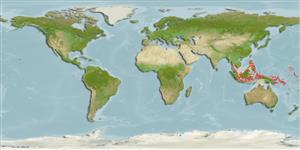>
Kurtiformes (Nurseryfishes, cardinalfishes.) >
Apogonidae (Cardinalfishes) > Apogoninae
Etymology: Siphamia: A Swazi word, siphama, for a fish.
Environment: milieu / climate zone / depth range / distribution range
पारिस्थितिकी
समुद्री प्रवाल-भित्ति संयुक्त; गहराई सीमा 6 - 22 m (Ref. 11890). Tropical
Western Central Pacific: Philippines and Malaysia south to Indonesia and Papua New Guinea. Probably occurs widely in the Indo-Malay and Melanesian archipelagos but has thus far escaped detection because of its small size and cryptic behavior.
आकार / वज़न / Age
Maturity: Lm ? range ? - ? cm
Max length : 3.1 cm SL पुल्लिंग / अलिंग; (Ref. 11890)
Short description
आकृति विज्ञान | मौरफोमैटरिक्स
पृष्ठीय रीढ़ (सम्पूर्ण): 8; पृष्ठीय सौफट रेज़ (सम्पूर्ण): 9; गुदा कांटा 2; ऐनल सौफट रेज़: 8.
Inhabits sheltered waters of lagoons and coastal inlets. Often seen in groups of approximately 30-40 individuals, hovering over pocilloporid coral Seriatopora hystrix (Ref. 11890).
Life cycle and mating behavior
परिपक्व अवधि | पुनरुत्पत्ति | मछलीऔ का अंडे देना | अंडे | Fecundity | लार्वा
Distinct pairing during courtship and spawning (Ref. 205).
Allen, G.R., 1993. Cardinalfishes (Apogonidae) of Madang Province, Papua New Guinea, with descriptions of three new species. Rev. Fr. Aquariol. 20(1):9-20. (Ref. 11890)
IUCN Red List Status (Ref. 130435)
Threat to humans
Harmless
Human uses
अधिक जानकारी
Age/Sizeबाढ़Length-weightLength-lengthLength-frequenciesमौरफोमैटरिक्सआकृति विज्ञानलार्वालारवल गतिकीभर्तीबहुतायतBRUVS
संदर्भजलीयकृषिजलीयकृषि रूपरेखाखींचआनुवंशिकीElectrophoresesहैरेटिबिलटीबीमारीप्रक्रमणNutrientsMass conversion
सहयोगीयोतस्वीरेStamps, Coins Misc.ध्वनिसिगुयटिरारफ्तारतैरने के प्रकारगिल क्षेत्रOtolithsदिमागदृष्टि
साधन
Special reports
Download XML
इंटरनेट स्रोत
Estimates based on models
Preferred temperature (Ref.
123201): 28.5 - 29.2, mean 28.9 °C (based on 650 cells).
Phylogenetic diversity index (Ref.
82804): PD
50 = 0.5000 [Uniqueness, from 0.5 = low to 2.0 = high].
Bayesian length-weight: a=0.01479 (0.00690 - 0.03171), b=3.09 (2.91 - 3.27), in cm total length, based on LWR estimates for this (Sub)family-body shape (Ref.
93245).
Trophic level (Ref.
69278): 3.2 ±0.5 se; based on size and trophs of closest relatives
लौटाव (Ref.
120179): ऊंचा, न्यूनतम जनसंख्या दुगनी समय अवलागत 15 महीने। (Preliminary K or Fecundity.).
Fishing Vulnerability (Ref.
59153): Low vulnerability (10 of 100).
